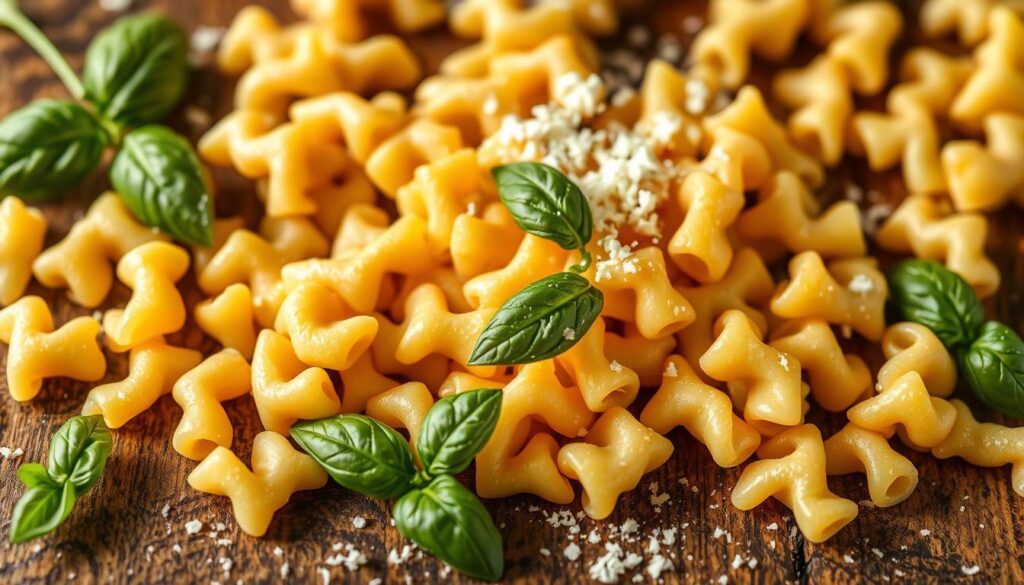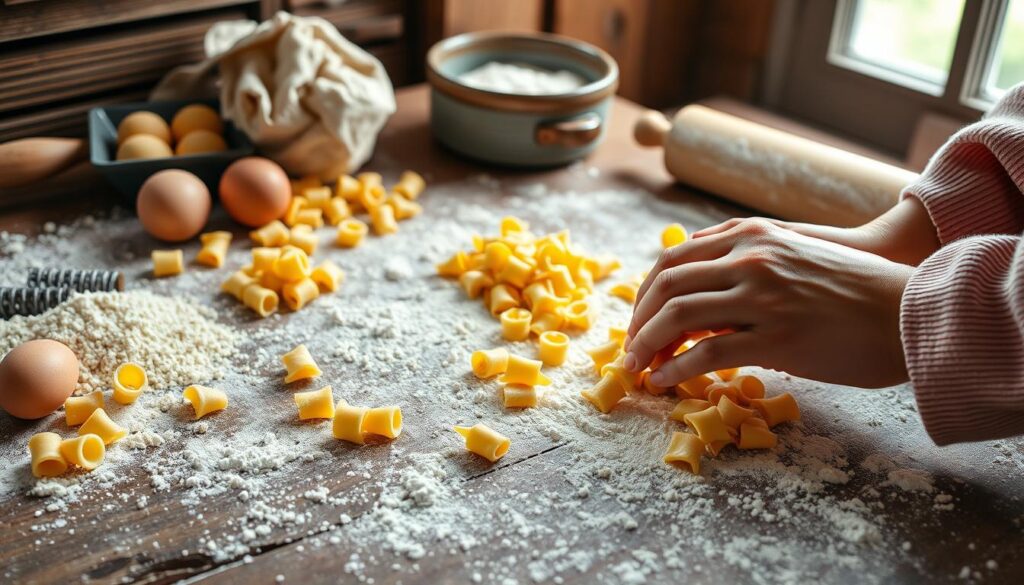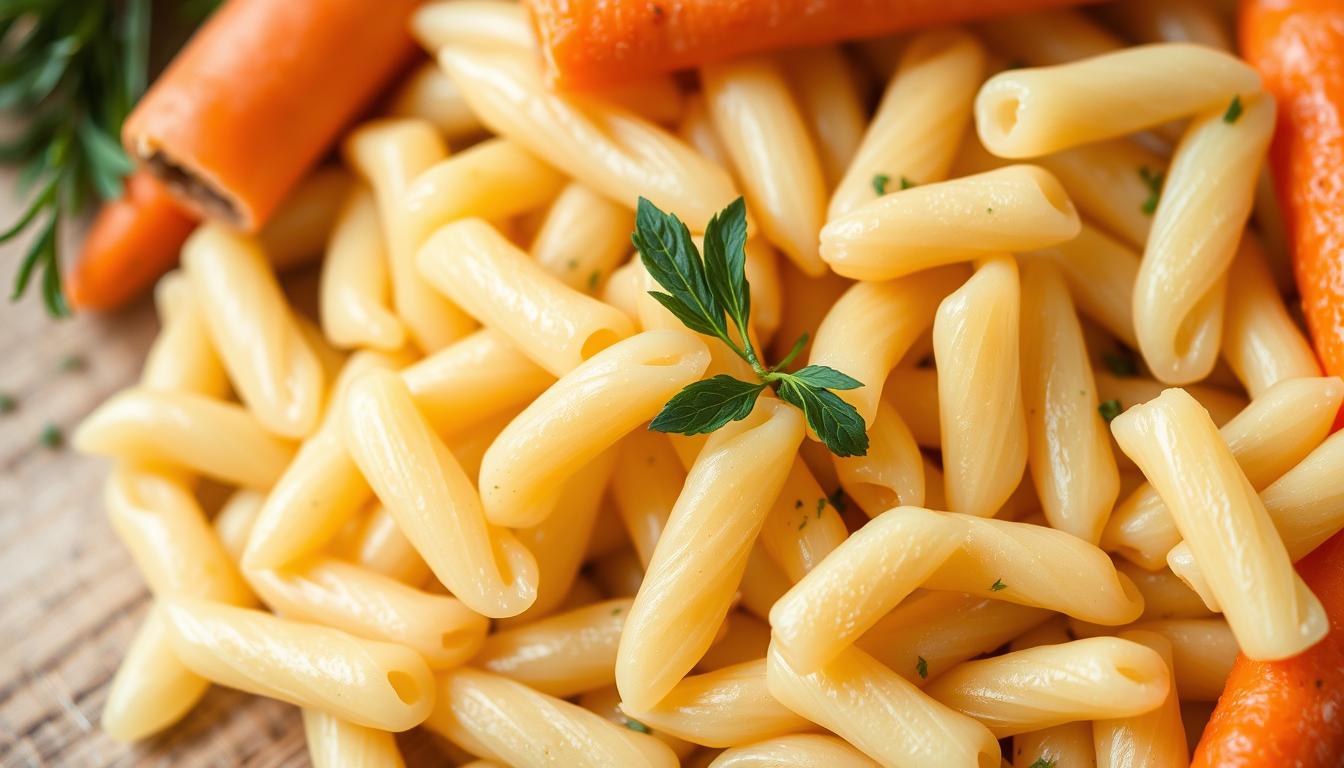Winter brings a need for warm, comforting soups. Ditalini pasta is key in many Italian soups. These small, ridged tubes hold onto broth and vegetables, making each spoonful flavorful.
Growing up in an Italian-American family, soups like Minestrone and Pasta e Fagioli were special. Ditalini pasta, with its unique shape, adds texture and heartiness to these dishes. It’s a favorite in our home, bringing back memories of family meals.
Key Takeaways
- Ditalini pasta is a small, tube-shaped pasta with ridges, perfect for capturing flavors in soups and stews.
- This versatile pastina is a staple in classic Italian dishes like Minestrone and Pasta e Fagioli.
- Ditalini pasta is made from high-quality durum wheat, ensuring a delicious texture and robust flavor.
- The size and shape of Ditalini make it ideal for use in a variety of soup recipes, as well as pasta salads and baked pasta dishes.
- Ditalini pasta is a nutritious and satisfying addition to your culinary repertoire, offering both comfort and versatility.
Understanding Ditalini: The Little Thimbles of Italian Pasta
Ditalini is a small, beloved pasta shape from Italy’s Puglia region. It looks like tiny thimbles and has a ridged texture. This texture helps it hold onto broths, sauces, and other ingredients well.
Origin and Traditional Uses
Ditalini pasta comes from Italy’s rich culinary traditions, especially in southern regions like Sicily. Its small size and shape are perfect for hearty soups and stews. It’s a favorite in many Italian homes and restaurants because it absorbs flavors well and has a satisfying bite.
Physical Characteristics of Ditalini
Ditalini’s small, cylindrical shape with ridges is its defining feature. This design makes it visually appealing and practical. The ridges and hollow interior trap and hold onto sauces and broths, blending flavors in every bite.
Why Size Matters in Pasta Shapes
Ditalini’s small size is intentional and serves a purpose in Italian cuisine. Smaller pasta shapes like Ditalini are great for soups and stews because they cook evenly. Their compact size also ensures a balanced ratio of pasta to other ingredients, making for a satisfying meal.

“Ditalini pasta is a true representation of the ingenuity and attention to detail that characterizes Italian culinary traditions. Its small size and unique shape make it the perfect companion for hearty soups and stews, showcasing the versatility and creativity of pasta as a staple in Italian cuisine.”
The Art of Making Authentic Ditalini Pasta
Making ditalini pasta is a skill passed down through generations in Puglia, Italy. It starts with top-quality durum wheat semolina flour. This flour gives the pasta its unique taste and texture.
The secret to great ditalini is in kneading the dough with cold, mineral-rich water. This careful kneading builds the pasta’s strength. It makes sure the pasta stays firm and cooks just right.
After the dough is ready, it goes through bronze dies. This step creates a rough surface. It’s perfect for holding onto sauces. This traditional method makes each ditalini piece a true Italian delight.
The last step is drying the pasta slowly at low temperatures. This keeps the pasta’s color, texture, and smell just right. It brings back the classic flavors that have made ditalini a favorite in Italian homes for years.

“The art of making ditalini pasta is a time-honored tradition that requires patience, skill, and a deep respect for the ingredients. Every step in the process is crucial in creating the perfect texture and flavor.”
Quality Ingredients: From Durum Wheat to Semolina Flour
The secret to making great ditalini pasta is in the ingredients. High-quality durum wheat is key. It affects how the pasta cooks, tastes, and feels.
The Role of High-Quality Wheat Selection
Ditalini pasta makers, like DeLallo, pick durum wheat with the best gluten and protein. This makes the pasta keep its shape, cook right, and feel firm.
Some, like Bona Furtuna, use organic, non-GMO wheat from Sicily. They grow it in the rich Sicilian soil. This ensures the pasta is top-notch.
Traditional Milling Process
After picking the wheat, it’s milled into semolina flour. This is done the old way to keep nutrients and texture. It’s vital for holding onto sauces and flavors.
The mix of premium durum wheat and traditional milling makes ditalini pasta special. It’s perfect for soups, salads, and more.

Perfect Cooking Techniques for Ditalini Pasta
To get the perfect al dente texture in your ditalini pasta, you need to pay close attention. Unlike cooking pasta in boiling water, soups don’t always boil. So, the pasta might take longer to cook right.
It’s crucial to taste the pasta as it cooks in soups. The cooking time on the box might not work because the soup’s liquid doesn’t boil constantly. Watch the texture closely and adjust the cooking time if needed.
When cooking ditalini pasta for soups, use less than you think. Ditalini absorbs a lot of liquid and gets bigger as it cooks. A good rule of thumb is to use about 100 grams (1/4 pound) of ditalini for a soup that serves four.
By following these pasta tips for cooking ditalini, your soups will have the perfect al dente texture in every bite.
“The key to flawlessly cooked ditalini pasta in soups is to taste-test regularly and utilize less than you think you’ll need. This small detail can make all the difference in achieving that coveted al dente bite.”
| Cooking Ditalini | Ditalini Pasta Tips |
|---|---|
|
|
Ditalini Pasta in Traditional Italian Soups
Ditalini pasta, with its delicate little tubes, is a star in Italian soups. It’s a key part of Minestrone and Pasta e Fagioli soups. Its small size ensures it cooks well with other ingredients, making the soup smooth.
Classic Minestrone
In Minestrone soup, ditalini pasta mixes with fresh veggies like carrots, celery, onions, and tomatoes. It thickens the broth, making the soup rich and satisfying. Across Italy, Minestrone varies, but ditalini is always there.
Pasta e Fagioli
Pasta e Fagioli also uses ditalini. It combines the pasta with beans, like white and kidney beans. This makes a comforting meal. The pasta soaks up the broth’s flavors perfectly.
Regional Soup Variations
In Italy’s diverse regions, many Italian soups feature ditalini. From Minestrone to Pasta e Fagioli, this pasta adds texture and depth. It’s a favorite ingredient in many dishes.
| Soup Type | Main Ingredients | Cooking Time | Nutritional Info (per serving) |
|---|---|---|---|
| Minestrone | Vegetables, ditalini pasta, broth | 8-9 minutes |
|
| Pasta e Fagioli | Beans, ditalini pasta, tomatoes, broth | 8-9 minutes |
|
Ditalini pasta is key in Italian soups like Minestrone and Pasta e Fagioli. Its small size and starch help make these soups flavorful and satisfying. It’s a must-have in traditional Italian cooking.
Beyond Soups: Creative Uses for Ditalini
Ditalini pasta is great in soups, but it’s also perfect for many other dishes. It’s small shape is great for showing off different flavors and textures. You can make vibrant pasta salads or comforting baked pasta with it.
Ditalini is amazing in cold pasta salads. Its small size lets it soak up dressings and herbs well. This makes the salad both tasty and pretty. It’s also great in creamy macaroni salads, where it fits well with rich dressings.
Want to make your meal more fun? Try using Ditalini in baked pasta recipes. It fits well in layers of cheese and sauce. Every bite is full of flavor and texture.
Ditalini is also good as a base for vegetable-centric dishes. It pairs well with roasted or sautéed veggies. Its small size is perfect for kids’ meals or adding fun to creative pasta recipes.
“Ditalini’s versatility extends far beyond the classic soup recipes. This small, unique pasta shape can bring a delightful touch of personality to a wide range of dishes, from vibrant salads to comforting baked creations.”
Next time you want to add Italian flair to your cooking, try Ditalini. It offers endless possibilities, far beyond soups.
Nutritional Benefits and Health Considerations
Ditalini pasta is a small, tube-shaped Italian pasta. It’s made from durum wheat. This pasta is a good source of complex carbohydrates, which give your body energy.
Protein and Carbohydrate Content
A 2-ounce serving of dried ditalini pasta has about 200 calories. It has 7 grams of protein and 2 grams of fiber. The protein helps build and maintain muscles, while the carbs give you energy.
Whole-wheat ditalini pasta has more protein and fiber than white pasta. This makes it a healthier choice.
Dietary Considerations
- There are gluten-free ditalini pasta options for those who need them.
- Pasta, including ditalini, is affordable and easy to add to a Mediterranean diet. This diet is known for being very healthy.
- Pasta dishes are quick to make, making them great for busy families.
The nutritional details of ditalini pasta can vary by brand and production. But, it’s a great addition to a healthy diet. It provides important nutrients and energy.
| Nutrient | Whole-Wheat Ditalini (100g) | Enriched Wheat Ditalini (100g) |
|---|---|---|
| Energy | 148 Kcal | 157 Kcal |
| Protein | 5.95g | 5.8g |
| Carbohydrates | 29.9g | 30.6g |
| Fiber | 3.9g | 1.8g |
“when enchanted in as parcel of a balanced eat less, can be a nutritious and sensible elective that gives essential supplements and vitality.”
Storage Tips and Shelf Life
Keeping Ditalini pasta fresh is key. To keep your pasta in top shape, follow these easy storage tips:
- Keep dry, uncooked Ditalini pasta in an airtight container in a cool, dry spot. This way, unopened packages can stay good for up to two years.
- After cooking, chill leftover Ditalini in an airtight container. It’s best to eat it within 3-5 days. Don’t store cooked pasta in soup, as it will soak up too much liquid and get mushy.
Dry pasta can last up to three years because it’s dried to less than 12% humidity. Fresh pasta, on the other hand, has more water, with a humidity of at least 24%. Homemade fresh pasta should be eaten within a few days. Store-bought fresh pasta can last about 30 to 90 days, longer than homemade.
| Pasta Type | Shelf Life (Unopened) | Shelf Life (Cooked) |
|---|---|---|
| Dry Pasta | Up to 3 years | 3-5 days (refrigerated) |
| Fresh Pasta | 30-90 days | 3-5 days (refrigerated) |
| Homemade Fresh Pasta | 3 days (refrigerated) | 3-5 days (refrigerated) |
By sticking to these storage tips, your Ditalini pasta will stay fresh and tasty. It’ll be ready for a variety of tasty dishes.
Best Substitutes and Alternative Options
If you can’t find DeLallo Ditalini pasta, there are great substitutes. Orzo has a mild taste and a soft, chewy texture. It’s perfect for dishes where size matters.
Acini di Pepe, tiny pasta spheres, add a unique texture and flavor. They’re great in soups and salads as a ditalini substitute.
Similar Pasta Shapes
For a gluten-free choice, try small shaped rice pasta or quinoa. Tubettini, a bit larger than ditalini, works well in minestrone or pasta e fagiole.
Elbow macaroni is firm and has a distinct taste. It’s a good ditalini substitute in casseroles and baked dishes.
When to Use Alternatives
When swapping ditalini, think about the cooking time and texture of the new pasta. It should match the dish well. Small-grain foods like couscous or bulgur wheat can add a twist to your cooking.

